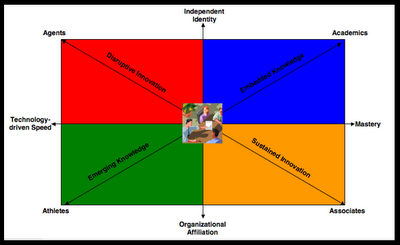Reports from the Knowledge Labs about our recent findings, research topics, and interviews with lifestyle leaders who are creating their own futures.
|
|
| |
How to stimulate your own powers of foresight. Consider the following thought provokers. Ask yourself, in these categories what are the brand new trends and forces? Which are the ones growing in importance? Which current forces are loosing their steam? Which have peaked or are reversing themselves? Which are the "wildcards" about to disrupt us in the future? POLITICAL AND TECHNICAL thought for food: Electronics, Materials, Energy, Fossil, Nuclear, Alternative, Other, Manufacturing (techniques), Agriculture, Machinery and Equipment, Distribution, Transportation (Urban, Mass, Personal, Surface, Sea, Subsurface, Space), Communication (Printed, Spoken, Interactive, Media), Computers (Information, Knowledge, Storage & Retrieval, Design, Network Resources), Post-Cold War, Third World, Conflict (Local, Regional, Global), Arms Limitation, Undeclared Wars, Terrorism, Nuclear Proliferation, Weapons of Mass Destruction, Governments (More/Less Power and Larger or Smaller Scale), Taxes, Isms: Nationalism, Regionalism, Protectionism, Populism, Cartels, Multinational Corporations, Balance of Trade, Third Party Payments, Regulations (OSHA, etc.) Environmental Impact, U.S. Prestige Abroad. SOCIAL AND ECONOMIC Food for thought:
Labor Movements, Unemployment / Employment Cycles, Recession, Employment Patterns, Work Hours / Schedules, Fringe Benefits, Management Approaches, Accounting Policies, Productivity, Energy Costs, Balance of Payments, Inflation, Taxes, Rates of Real Growth, Distribution of Wealth, Capital Availability and Costs, Reliability of Forecasts, Raw Materials, Availability and Costs, Global versus National Economy, Market versus Planned Economies, Generations: Y, X, Boomers, Elderly, Urban vs. Rural Lifestyles, Affluent vs. Poor, Neighborhoods and Communities, Planned or Organic Growth.
Got Knowledge?
|
|
| |
|
|
|
|
The Journal of 2020 Foresight
|
|
| |
|
Friday, August 04, 2006

Talented Tribes: Speed to Disrupt and Emerge, Mastery to Sustain and Embed
Chapter Four: The Tribal Territories
By Steve Howard, CKO
The Knowledge Labs
Table of Contents
Chapter One: Basecamp
Chapter Two: The Ridge
Chapter Three: The Outpost
Chapter Four: The Tribal Territories
“So when Grandpa died, it was a surprise to everybody. I’m sorry, I wish it had been a happier story up to this point. But we still have youth. We still have youth on our side. Living in that house is that beautiful little girly, ready to breakout. And right now Grandma’s driving around, they’ve got this car, it’s a huge white Eldorado, a ’78 Eldorado. It’s very big and very wide.“
Neil Young & Crazy Horse “Greendale”
DOUBLE NICKEL RANCH. Agents, Athletes, Associates and Academics straddle the four corner positions in the matrix defined by the intersection of speed and mastery with independence and affiliation.
Journal of 2020 Foresight: What do the diagonal lines connecting the four corners signify?
Explorer: The line between Agents and Associates describes the progression between the introduction of a disruptive innovation and what an organization must do to sustain that innovation over time.
J2020F: So that would be the line along which continuous innovation morphs into continuous incremental improvement?
Explorer: And along multiple products in a category to sustain a competitive advantage in the marketplace.
J2020F: How do you differentiate that trajectory from the other stretching from green to blue?
Explorer: It takes dedicated teamwork to overcome all the false starts to take a brand new innovation to market.
J2020F: So, the learning that takes place through the process of sheer will and determination yields something valuable?
Explorer: Yes, we call that first-time learning carried forward emerging knowledge. Over time, with more experience the early learning usually gets discarded.
J2020F: But the enduring knowledge – now the responsibility of the academics becomes embedded knowledge?
Explorer: Yes. At that time new comers, who hadn’t benefited from the early teamwork can learn the methodology and processes to perform their work more efficiently.
J2020F: Who are the Breakpoint Inventors? Are they really Agents?
Got Knowledge?
Copyright ©2002 - 2006 Aarnaes Howard Associates. All rights reserved worldwide.
7:17 AM
|
|
| |
|
|
|